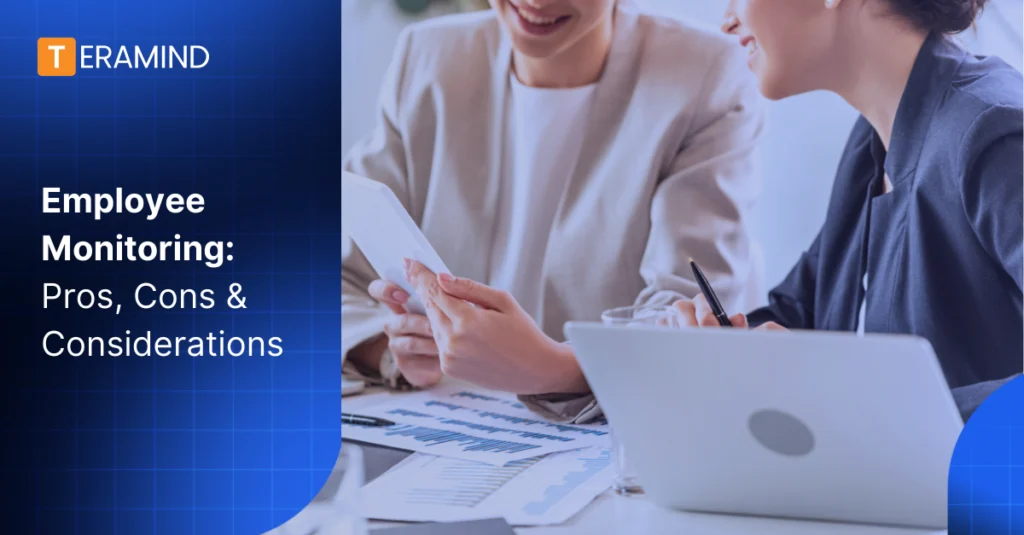Organizational leaders and business owners continue to face cybersecurity and productivity, and many have turned to employee monitoring tools. Some organizations may have misconceptions about the nature and possibilities of monitoring, however. When making major decisions about new technology, a simple pros and cons list can help simplify the issue.
The business environment has changed in recent years with the influx of millennials, who are the largest segment of the workforce. This group approaches work and business culture differently. PwC conducted a recent survey on workplace environments, finding that the trust between executives and their teams shows significant signs of erosion.
Post-pandemic culture is very different than pre-pandemic culture, and recent return to office policies, among other factors, have surfaced philosophical differences. Workers want to be sure they have the flexibility to do good work, and executives want to be sure enough time and effort are being put forth to move the company forward.
At the same time, the widespread emergence of unethical remote work practices like “mouse jiggling” on personal devices has led major corporations like Wells Fargo to hold employees who falsify work activity accountable. This practice indicates the need for measures such as employee monitoring for remote workers. It also speaks to the need for work environments where employees take enough routine breaks and have interesting, varied work to keep them moving.
While employee monitoring is a hot topic for workers, especially as of late, there is a way to monitor activities transparently and in a way that honors any privacy concerns without compromising policy enforcement. In this article, we’ll explore the potential impacts of employee monitoring and offer best practice tips for balancing trust and security.
The Pros of Employee Monitoring: A Path to Optimism
For organizations that genuinely care about their people’s success, monitoring employee computer activity can be a helpful practice for making the work experience better for everyone.
This includes clearly communicating the purpose of monitoring, creating policies and controls that ensure data collected is used only for business analysis, efficiency, and security purposes..
Let’s explore a few specific advantages of employee monitoring in detail.
Increased Employee Productivity and Better Resource Management
Monitoring employee productivity allows you to identify inefficiencies and needless tasks that prevent team members from contributing to strategic goals. This means that managers and organizational leaders can solve these bottlenecks together.
Currently, with a lack of empirical data around how their employees work, executives have a hard time understanding their position. With full visibility, 70% of organizational business leaders who currently do not collaborate with their front-line managers can begin doing so from an informed place.
Collaboration allows you to improve productivity together for much better outcomes. Then, you can be sure resource allocation decisions make sense for meeting shared business goals.
Employees will appreciate their managers’ ability to represent their needs in major company decisions, and that is a major positive cultural change.
Enhanced Security
Cybersecurity threats and malicious insiders can expose not only company data but also employee data. Moreover, AI has empowered bad actors with even more sophisticated tools for carrying out attacks. Protecting corporate and employee data is a shared goal that can unify leaders and employees who are unsure of what monitoring means for their work.
When people understand the threat, they typically want to help prevent problems as team players. Monitoring helps your teams understand the seriousness of threats that can be stopped in their tracks, and it is a good way to ensure you are all on the same page.
Nobody wants to be the mule or threat vector who lets attackers in the door. Without monitoring, however, it’s impossible to catch anomalies in internal and external communications.
According to their research for Bessemer Venture Partners, cybersecurity experts Mike Droesch, Amit Karp, and Yael Schiff say today’s cybercriminals are “exploiting generative AI tools like ChatGPT to create highly targeted business email compromise (BEC) and other phishing campaigns. And we are already seeing widespread use of other AI tools like voice cloning services to deliver more impactful social engineering attacks.”
With the increase of these advanced attacks, company leaders are looking to create zero-trust security models. These models, which include employees as part of their defensive line, operate on the principle of ‘never trust, always verify.‘ This means that even within the company network, all users and devices are treated as potential threats, making increased security one of the benefits of employee monitoring.
This is why organizations need enhanced employee monitoring platforms that also offer comprehensive behavior analysis. This could include tracking the frequency and timing of data access, monitoring for unusual data transfer patterns, and flagging any attempts to access unauthorized data. These features allow leaders to establish a behavioral baseline for network navigation and information sharing that better protects them from intentional or unintentional data breaches.
Improved Quality Control
When employees feel engaged, satisfied, and effective in their roles, they can easily adhere to compliance and security policies and procedures. However, with global employee burnout on the rise, companies need automated platforms that monitor for quality assurance.
Why? Not only is it contributing to more occurrences of sleep disturbances, cardiovascular disease, gastrointestinal issues, depression, absenteeism, and job dissatisfaction in the workforce, but, as professor and burnout expert Kandi Wiens writes for HBR, “burned-out workers are more likely to make errors and less likely to be innovative and productive. Gallup estimates low employee engagement (a hallmark of burnout) costs the global economy $8.8 trillion, or 9% of the global gross domestic product.”
Employee monitoring software has tangible benefits as long as it’s not being used to hold stressed-out employees accountable. It can help managers and team members pinpoint areas where quality assurance and QR processes may have been neglected and identify opportunities for employee training and skill development when needed.
Cons of Employee Monitoring
Without a clear, honest plan of action that takes employee interests and goals into account, employee monitoring can lead to broken trust and unethical use of data. Let’s explore the potential disadvantages of employee monitoring in greater depth.
Invasion of Privacy and Decreased Job Satisfaction
“There are good and not-so-good reasons to use monitoring software,” says David Brodeur-Johnson, Forrester’s principal analyst and employee experience research lead in a piece for SHRM.“ It has everything to do with what your intent is as an employer and whether your employees trust that intent. If your goal only is to find slackers and punish them, it likely will create problems in terms of employee motivation and retention.”
In terms of privacy concerns, this illustrates that if workers feel that employee monitoring uses invasive methods and is only being used to surveil their work and penalize them for not meeting unclear expectations or taking too many “browsing breaks,” it could decrease employee morale even among high-performing workers and make them feel that executives don’t trust them and see sacrificing autonomy among employees and privacy rights merely as the cost of doing business.
Besides employee turnover and retention issues, monitoring remote employees without their consent could land your company in legal trouble for privacy invasion. For instance, California is conducting deeper investigations into potential violations of the California Consumer Privacy Act, which also protects employees from employers looking to share or sell their personal data and gives them the right to opt-out from sharing personal information.
Controlling How Data is Accessed and Used
When it comes to employees’ activity data, ensure that those with access to view this data are a very small, trusted group with a great deal of oversight. This means shortlisting target providers to those platforms which support role-based access control, log all activity of admins, and has other privacy features. These measures and configurations can be included in company policies as a means to demonstrate to employees the level of trust you are ready to build both directions.
Monitoring employee activities can actually help build trust, although it’s good to be thoughtful about your approach. When employers collaborate with team members on its implementation, employee monitoring tools can improve the work experience for everyone company-wide, regardless of their role.
Establishing Clear Company Policies and Guidelines for Monitoring
Employees don’t want to feel like they’re constantly being scrutinized or, worse, micromanaged, regardless of whether they’re working in the office or in a remote environment. To avoid this, it’s best to collaborate with your HR team to design an employee monitoring strategy that benefits everyone.
Ideas for what you can ask employees:
- In which ways, if any, could employee monitoring tools help you improve your work experience?
- Do you have a personal machine on which you can perform personal, non-work related tasks to help keep your work data clean??
- Do you have any thoughts or ideas about monitoring that you would like to discuss with our HR leadership?
Using their answers and any resulting discussions to work together with departmental leaders on the creation of clear guidelines for employee performance monitoring that benefit everyone.
Communicating Transparently with Employees About Monitoring Practices and Acceptable Use Policies
Make sure team members know your company’s exact reasons for monitoring employee activities. You shouldn’t, for instance, say that you’re tracking employees for cybersecurity reasons alone, yet refer to their internet usage statistics in a performance review.
Let workers know exactly what metrics and activities you track, how you report those activities, how those metrics affect business processes, and whether employees will be held accountable for those activities.
Focusing on Performance Outcomes
Robust user behavior analytics platforms provide you with rich data, such as who is performing well, what is leading to their success, and even what tasks may benefit worker productivity if they were streamlined. Seeing your workforce as a living organism to be studied, understood, and supported allows you to contextualize data in the right mindset for helping people reach their highest levels of performance.
FAQs
What are the positive and negative aspects of employee monitoring?
The positive aspects of employee monitoring include increased productivity, improved compliance with company policies, and enhanced data security. However, some employees may raise concerns about privacy. These concerns can be heard, taken seriously, and addressed with proper policies and access control.
What are the risks of employee monitoring?
The key risks of employee monitoring are specific to improper implementations, lack of policy and security controls, or overcollection of data. .
What are the advantages of monitoring employee performance?
The advantages of monitoring employee performance include increased productivity, improved adherence to company policies, and enhanced data security. Monitoring can help identify areas for improvement, provide valuable insights for performance evaluations, and ensure that employees are meeting expectations.
Conclusion
Employers and experts have been hotly debating the topic of employee monitoring for the past couple of years, and its ethics have recently come into question with the evolution of AI and recent “fake work” firings.
However, employee monitoring tools can greatly improve the work experience, enhance your workplace culture, and elevate any business strategy.
And that’s where Teramind comes in. By uncovering inefficiencies and encouraging more transparent monitoring practices, Teramind offers privacy-friendly employee monitoring settings, automation, and business intelligence tools, providing you with valuable insights you need to drive better business results and boost employee satisfaction.


